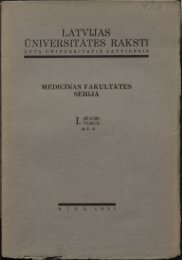ornamental sign language in the first order tracery belts - DSpace
ornamental sign language in the first order tracery belts - DSpace
ornamental sign language in the first order tracery belts - DSpace
Create successful ePaper yourself
Turn your PDF publications into a flip-book with our unique Google optimized e-Paper software.
Tenisons, M; Zeps, D. Ornamental Sign Language In The First Order Tracery Belts<br />
We see that here <strong>the</strong> ratio 3/2 plays a decisive role. Besides, this ratio is <strong>sign</strong>ificant <strong>in</strong> some<br />
mystical teach<strong>in</strong>gs.<br />
We call this pr<strong>in</strong>ciple of aris<strong>in</strong>g ornament from volume parts of background and<br />
volume parts of code as if <strong>in</strong>terplay<strong>in</strong>g between <strong>the</strong>mselves that we describe here hemiolia<br />
pr<strong>in</strong>ciple. In Greek – one and a half.<br />
Sieve displacement<br />
The notion of sieve displacement arises by observ<strong>in</strong>g that displac<strong>in</strong>g <strong>the</strong> sieve by three<br />
checks or, what is <strong>the</strong> same, displacement of code by one row gives different ornament<br />
pattern that is equivalent of <strong>the</strong> exchange of colors of cross lattices. Thus, if we add empty<br />
code l<strong>in</strong>e <strong>in</strong> <strong>the</strong> ornament cod<strong>in</strong>g, we get quite a new <strong>ornamental</strong> pattern, that what we were<br />
to obta<strong>in</strong> by sieve displacement.<br />
Ma<strong>the</strong>matically, <strong>the</strong> th<strong>in</strong>gs we consider here are almost trivial, but <strong>the</strong>y effect on human<br />
imag<strong>in</strong>ation not <strong>in</strong> <strong>the</strong> least sense <strong>in</strong> a trivial manner. The discussion <strong>in</strong> this direction see<br />
below. Anyhow, let us bear <strong>in</strong> m<strong>in</strong>d that <strong>ornamental</strong> <strong>belts</strong>’ weavers who are directly<br />
connected with <strong>the</strong>se <strong>belts</strong>, because just <strong>the</strong>y are who have <strong>in</strong>vented <strong>the</strong>m, don’t know <strong>the</strong>se<br />
simple facts as clearly as <strong>the</strong>y stand <strong>in</strong> any ma<strong>the</strong>matical sett<strong>in</strong>g and never<strong>the</strong>less <strong>the</strong>y were<br />
and are able to obta<strong>in</strong> miracles quite <strong>in</strong> literal sense, like <strong>in</strong> <strong>the</strong> case of Nica belt, not even to<br />
speak about <strong>the</strong> belt of Lielvārde.<br />
Picture 4. Two ornament patterns from <strong>the</strong> same <strong>ornamental</strong> code. We may say that one is obta<strong>in</strong>ed by o<strong>the</strong>r<br />
us<strong>in</strong>g sieve displacement. We can see that we can’t fix <strong>the</strong> exact difference by “ma<strong>the</strong>matically non equipped<br />
eye” as some simple trick. Nei<strong>the</strong>r did most prolific masters as weavers of <strong>the</strong> most wonderful <strong>belts</strong>, who only<br />
“knew” <strong>the</strong> rule by some “<strong>in</strong>strumental” sense, that <strong>the</strong>y couldn’t formulate directly.<br />
Picture 5. The belt of Nica <strong>in</strong> two variations. On <strong>the</strong> right sieve displacement is performed by add<strong>in</strong>g empty<br />
code row at <strong>the</strong> beg<strong>in</strong>n<strong>in</strong>g giv<strong>in</strong>g ano<strong>the</strong>r pattern of Nica belt <strong>tracery</strong>. Visual effect is such as if we had quite<br />
ano<strong>the</strong>r sample of Nica belt.<br />
5



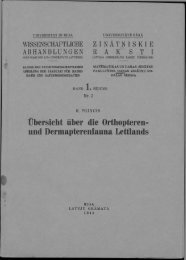
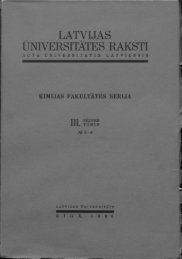
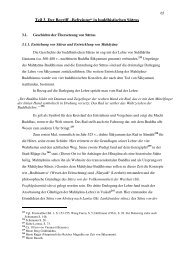
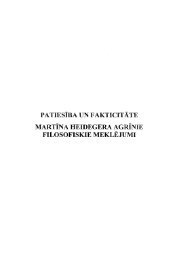
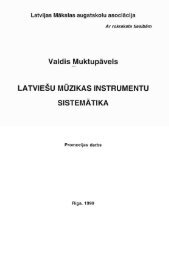
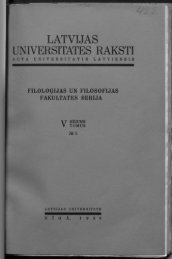
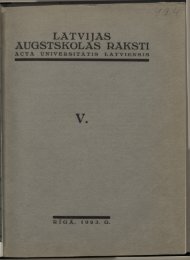


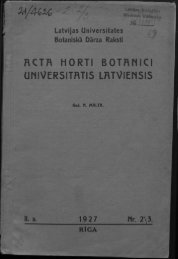
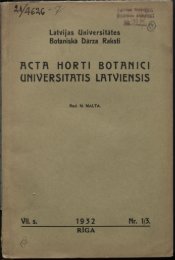
![LATVIJAS] - DSpace](https://img.yumpu.com/11778577/1/190x249/latvijas-dspace.jpg?quality=85)
